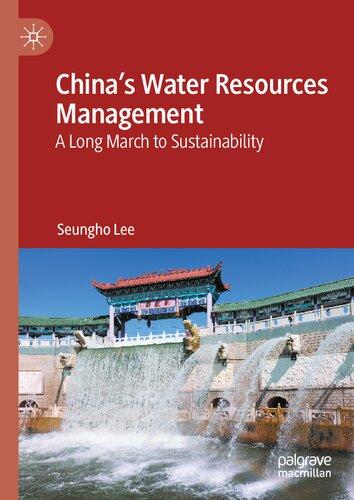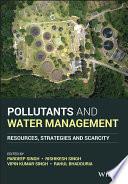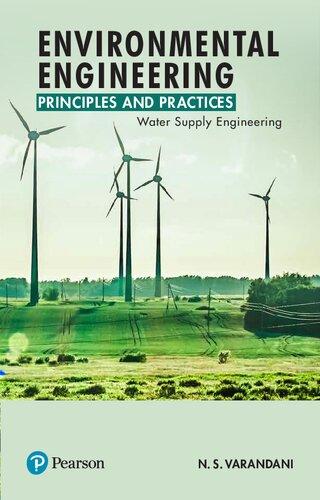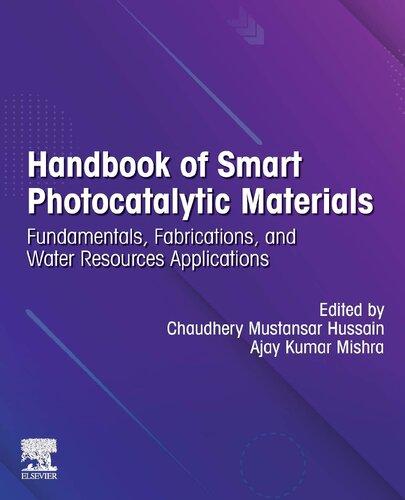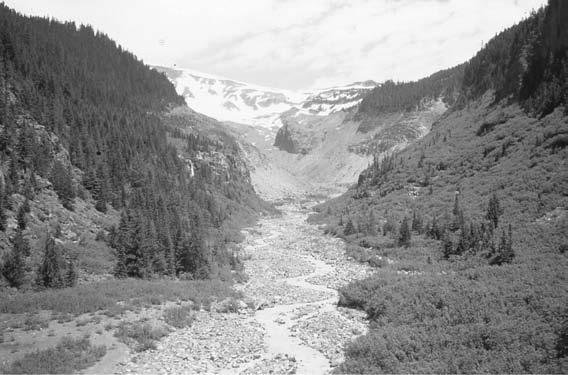Water-Resources Engineering David A. Chin Visit to download the full and correct content document: https://ebookmass.com/product/water-resources-engineering-david-a-chin/
More products digital (pdf, epub, mobi) instant download maybe you interests ...
Water Resources Engineering 3rd Edition, (Ebook PDF)
https://ebookmass.com/product/water-resources-engineering-3rdedition-ebook-pdf/
China's Water Resources Management: A Long March to Sustainability Seungho Lee
https://ebookmass.com/product/chinas-water-resources-managementa-long-march-to-sustainability-seungho-lee/
Water Resources in the Mediterranean Region 1st Edition Mehrez Zribi
https://ebookmass.com/product/water-resources-in-themediterranean-region-1st-edition-mehrez-zribi/
Pollutants and Water Management : Resources, Strategies and Scarcity 1st Edition Pardeep Singh
https://ebookmass.com/product/pollutants-and-water-managementresources-strategies-and-scarcity-1st-edition-pardeep-singh/
Engineering Drawing and Design, 6th edition David A. Madsen
https://ebookmass.com/product/engineering-drawing-and-design-6thedition-david-a-madsen/
Environmental Engineering Principles and Practices (Water Supply Engineering) N. S. Varandani
https://ebookmass.com/product/environmental-engineeringprinciples-and-practices-water-supply-engineering-n-s-varandani/
Handbook of Smart Photocatalytic Materials: Fundamentals, Fabrications and Water Resources Applications Chaudhery Mustansar Hussain
https://ebookmass.com/product/handbook-of-smart-photocatalyticmaterials-fundamentals-fabrications-and-water-resourcesapplications-chaudhery-mustansar-hussain/
Transboundary Water Resources in Afghanistan. Climate Change and Land-Use Implications 1st Edition John F. Shroder
https://ebookmass.com/product/transboundary-water-resources-inafghanistan-climate-change-and-land-use-implications-1st-editionjohn-f-shroder/
Water and Wastewater Engineering: Design Principles and Practice Second Edition Mackenzie L. Davis
https://ebookmass.com/product/water-and-wastewater-engineeringdesign-principles-and-practice-second-edition-mackenzie-l-davis/
LibraryofCongressCataloging-in-PublicationData Chin,DavidA. Water-resourcesengineering/DavidA.Chin.–3rded. p.cm.
ISBN-13:978-0-13-283321-9(alk.paper)
ISBN-10:0-13-283321-2(alk.paper) 1.Hydraulics.2.Hydrology.3.Waterworks.4.Waterresources development.I.Title.
TC160.C522014 627–dc232012018911
VicePresidentandEditorialDirector,ECS: MarciaJ.Horton
ExecutiveEditor: HollyStark
EditorialAssistant: CarlinHeinle
ExecutiveMarketingManager: TimGalligan
MarketingAssistant: JonBryant
PermissionsProjectManager: KarenSanatar
PearsonEducationAustraliaPty.Ltd., Sydney
PearsonEducationSingapore,Pte.Ltd.
PearsonEducationNorthAsiaLtd., HongKong
www.EasyEngineering.net PearsonEducationCanada,Inc., Toronto
PearsonEducaci ´ ondeMexico,S.A.deC.V.
PearsonEducation—Japan, Tokyo
PearsonEducationMalaysia,Pte.Ltd.
PearsonEducation, UpperSaddleRiver,NewJersey
www.EasyEngineering.net www.EasyEngineering.net 3.3.2Pumps...................................85
3.3.5FireHydrants...............................86
3.3.6Water-StorageReservoirs........................87
3.4PerformanceCriteriaforWater-DistributionSystems...
3.4.1ServicePressures.............................91
3.4.2AllowableVelocities...........................91
3.4.3WaterQuality...............................91 3.4.4NetworkAnalysis.............................92
3.5BuildingWater-SupplySystems.
3.5.1SpecificationofDesignFlows...
3.5.3DeterminationofPipeDiameters....................96
5.1Introduction..
5.2.1BestHydraulicSection..
5.2.2BoundaryShearStress..
5.2.3CohesiveversusNoncohesiveMaterials.
5.2.5ChannelSlopes.
5.2.6Freeboard
5.3DesignofChannelswithRigidLinings..
5.4DesignofChannelswithFlexibleLinings.
5.4.1GeneralDesignProcedure
5.4.2VegetativeLiningsandBareSoil.
5.4.3RECPLinings..
5.4.4Riprap,Cobble,andGravelLinings
5.4.5Gabions..................................203
5.5CompositeLinings.................................205
6DesignofSanitarySewers211
6.1Introduction..
6.2QuantityofWastewater.
6.2.1ResidentialSources
6.2.2NonresidentialSources..
6.2.3InflowandInfiltration(I/I)
6.2.4PeakingFactors. .............................214
6.3HydraulicsofSewers...............................216
6.3.1ManningEquationwithConstant
6.3.2ManningEquationwithVariable
6.3.3Self-Cleansing..
6.3.4ScourPrevention
6.3.5DesignComputationsforDiameterandSlope.............224
6.3.6HydraulicsofManholes.
7.2.1Hydraulics.................................250
7.2.1.1Submergedentrances..
7.2.3SizingCalculations............................264
7.2.3.1Fixed-headwatermethod
7.2.3.2Fixed-flowmethod
7.2.3.3Minimum-performancemethod
7.2.4RoadwayOvertopping..
7.2.5Riprap/OutletProtection.........................274
7.4.1Sharp-CrestedWeirs...
7.4.1.1Rectangularweirs
7.4.1.3Compoundweirs ........................291
7.4.1.4Othertypesofsharp-crestedweirs
7.4.2Broad-CrestedWeirs...
7.4.2.1Rectangularweirs
7.4.2.2Compoundweirs ........................297
7.4.2.3Gabionweirs..........................298
7.5Spillways ......................................299
7.5.1UncontrolledSpillways..
7.5.2Controlled(Gated)Spillways...
7.5.2.1Gatesseatedonthespillwaycrest
7.5.2.2Gatesseateddownstreamofthespillwaycrest.. .....309
7.6StillingBasins. ..................................312
7.6.1TypeSelection...............................312
7.6.2DesignProcedure .............................314
7.7DamsandReservoirs...............................318
7.7.1TypesofDams..
7.7.2ReservoirStorage.............................322
8.2.5.7Log-normaldistribution.
8.2.5.8Uniformdistribution......................363
8.2.5.9Extreme-valuedistributions...
8.2.5.10Chi-squaredistribution.
8.3AnalysisofHydrologicData...........................372
8.3.1EstimationofPopulationDistribution..
8.3.1.1Probabilitydistributionofobserveddata
8.3.1.2Hypothesistests ........................376
8.3.1.3Modelselectioncriteria.
8.3.2EstimationofPopulationParameters...
8.3.2.1Methodofmoments......................379
8.3.2.2Maximum-likelihoodmethod..
8.3.2.3MethodofL-moments.....................383
8.3.3FrequencyAnalysis ............................387
8.3.3.1Normaldistribution...
8.3.3.2Log-normaldistribution.
8.3.3.3Gamma/PearsonTypeIIIdistribution..
8.3.3.4Log-PearsonTypeIIIdistribution
8.3.3.5Extreme-valueTypeIdistribution
8.3.3.6Generalextreme-value(GEV)distribution .........394 8.4UncertaintyAnalysis.. .............................395 Problems.........................................397
9FundamentalsofSurface-WaterHydrologyI:RainfallandAbstractions401
9.1Introduction.. ..................................401 9.2Rainfall.......................................401
9.2.1MeasurementofRainfall.........................403
9.2.2StatisticsofRainfallData........................405
9.2.2.1RainfallstatisticsintheUnitedStates............410
9.2.2.2SecondaryestimationofIDFcurves... ..........410
9.2.3SpatialAveragingandInterpolationofRainfall.. ..........416
9.2.4DesignRainfall..............................421
9.2.4.1Returnperiod.........................421
9.2.4.2Rainfallduration........................422
10FundamentalsofSurface-WaterHydrologyII:Runoff473 10.1Introduction..
10.2MechanismsofSurfaceRunoff..
10.3.1OverlandFlow..............................474 10.3.1.1Kinematic-waveequation
10.3.3AccuracyofEstimates..
10.4Peak-RunoffModels..
10.4.1TheRationalMethod...
10.5.2InstantaneousUnitHydrograph..
10.5.3Unit-HydrographModels ........................502
10.5.3.1Snyderunit-hydrographmodel. ...............503
10.5.3.2NRCSdimensionlessunithydrograph.. ..........506
10.5.3.3Accuracyofunit-hydrographmodels.. ..........509
10.5.4Time-AreaModels ............................509
10.5.5Kinematic-WaveModel. ........................514
10.5.6Nonlinear-ReservoirModel .......................515
10.5.7SantaBarbaraUrbanHydrographModel ...............517
10.5.8ExtremeRunoffEvents. ........................519
10.6RoutingModels ..................................520
10.6.1HydrologicRouting............................520
10.6.1.1ModifiedPulsmethod.....................520
10.6.1.2Muskingummethod... ...................524
10.6.2HydraulicRouting............................531
10.7Water-QualityModels.. .............................533
10.7.1Event-MeanConcentrations .......................533
10.7.2RegressionEquations.. ........................535
10.7.2.1USGSmodel.. ........................535
12DesignofStormwater-ManagementSystems586
12.1Introduction..
12.3.1.4Designofoutletstructures..................593 12.3.1.5Designforfloodcontrol.
12.3.5BioretentionSystems...........................610
12.3.6ExfiltrationTrenches... ........................612
12.3.6.1Generaldesignguidelines ...................613
12.3.6.2Designforfloodcontrol. ...................614
12.3.6.3Designforwater-qualitycontrol...............616
12.3.7SubsurfaceExfiltrationGalleries. ...................617
12.4SelectionofSCMsforWater-QualityControl.................618
12.4.1NonstructuralSCMs...........................618
12.4.2StructuralSCMs..............................618
12.4.3OtherConsiderations...........................619 12.5MajorDrainageSystem. .............................619 Problems.........................................619
13EstimationofEvapotranspiration624
13.1Introduction.. ..................................624
13.2Penman–MonteithEquation... ........................624
13.2.1AerodynamicResistance. ........................625
13.7SelectionofETEstimationMethod.......................654 Problems.........................................654
14FundamentalsofGroundwaterHydrologyI:GoverningEquations656 14.1Introduction.. ..................................656 14.2Darcy’sLaw....................................662
14.2.1HydraulicConductivity.. ........................666
14.2.1.1Empiricalformulae......................666
14.2.1.2Classification.. ........................670 14.2.1.3Anisotropicproperties.....................670 14.2.1.4Stochasticproperties...
14.3GeneralFlowEquation. .............................676
14.4Two-DimensionalApproximations .......................681
14.4.1UnconfinedAquifers... ........................681 14.4.2ConfinedAquifers ............................687
14.5FlowintheUnsaturatedZone..........................691 Problems.........................................696
15FundamentalsofGroundwaterHydrologyII:Applications700
15.1Introduction.. ..................................700
15.2Steady-StateSolutions. .............................700
15.2.1UnconfinedFlowBetweenTwoReservoirs ..............700
15.2.2WellinaConfinedAquifer
15.2.3WellinanUnconfinedAquifer..
15.2.4WellinaLeakyConfinedAquifer.
15.2.5WellinanUnconfinedAquiferwithRecharge... ..........713 15.2.6PartiallyPenetratingWells ........................714
15.3Unsteady-StateSolutions .............................718
15.3.1WellinaConfinedAquifer
15.3.2WellinanUnconfinedAquifer..
15.3.3WellinaLeakyConfinedAquifer.
15.3.4OtherSolutions..............................741
15.4PrincipleofSuperposition ............................741
15.4.1MultipleWells...............................742
15.4.2WellinUniformFlow..........................744 15.5MethodofImages
16.4.4WellDrilling...
16.5DesignofAquiferPumpingTests........................794
16.5.1PumpingWell...............................794
16.5.2ObservationWells............................795
16.6DesignofSlugTests................................798
16.7DesignofExfiltrationTrenches.
16.8SeepageMeters
17.3.1.3Arithmetic-gradientfactors..................820
17.3.2.1Present-worthanalysis..
17.3.2.2Annual-worthanalysis..
17.3.2.3Rate-of-returnanalysis.
www.EasyEngineering.net Preface Water-resourcesengineersdesignsystemstocontrolthequantity,quality,timing,anddistributionofwatertosupporthumanhabitationandtheneedsoftheenvironment.Water-supply andflood-controlsystemsarecommonlyregardedasessentialinfrastructurefordeveloped areas,andassuchwater-resourcesengineeringisacorespecialtyareaincivilengineering. Water-resourcesengineeringisalsoaspecialtyareainenvironmentalengineering,particularlywithregardtothedesignofwater-supplysystems,wastewater-collectionsystems,and water-qualitycontrolinnaturalsystems.
Thetechnicalandscientificbasesformostwater-resourcesapplicationsareintheareas ofhydraulicsandhydrology,andthistextcoverstheseareaswithdepthandrigor.Thefundamentalsofclosed-conduitflow,open-channelflow,surface-waterhydrology,groundwater hydrology,andwater-resourcesplanningandmanagementareallcoveredindetail.Applicationsofthesefundamentalsincludethedesignofwater-distributionsystems,hydraulicstruc-
linings.Thedesignofsanitary-sewersystemsiscoveredinChapter6,whichincludesdesign approachesforestimatingthequantityofwastewatertobehandledbysewers;sizingsewer pipesbasedonself-cleansingandcapacityusingtheASCE-recommendedtractive-force method;andtheperformanceofmanholes,forcemains,pumpstations,andhydrogen-sulfide controlsystemsarealsocovered.Designofthemostwidelyusedhydraulicstructuresis coveredinChapter7,whichincludesthedesignofculverts,gates,weirs,spillways,stilling basins,anddams.Thischapterisparticularlyimportantsincemostwater-resourcesprojects relyontheperformanceofhydraulicstructurestoachievetheirobjectives.Thebasesfor thedesignofwater-resourcessystemsaretypicallyrainfalland/orsurfacerunoff,whichare randomvariablesthatmustgenerallybespecifiedprobabilistically.Applicationsofprobabilityandstatisticsinwater-resourcesengineeringarecoveredindetailinChapter8,with particularemphasisontheanalysisofhydrologicdataanduncertaintyanalysisinpredicting hydrologicvariables.Thefundamentalsofsurface-waterhydrologyarecoveredinChapters9 and10.Thesechapterscoverthestatisticalcharacterizationofrainfallfordesignapplications,methodologiesforestimatingpeakrunoffandrunoffhydrographs,methodologiesfor routingrunoffhydrographsthroughdetentionbasins,andmethodsforestimatingthequalityofsurfacerunoff.Thedesignofstormwater-collectionsystemsiscoveredinChapter11,
includingthedesignofstormwaterinletsandstormsewers.Stormwater-managementsystems aredesignedtotreatstormwaterpriortodischargeintoreceivingwaters,andthedesignof thesesystemsiscoveredinChapter12.Severalstate-of-the-artdesignexamplesforthemost commonlyusedstormwater-controlmeasuresareprovided,includingthedesignofinfiltrationbasins,swales,filterstrips,bioretentionsystems,andexfiltrationtrenches.Theestimation ofevapotranspiration,whichisusuallythedominantcomponentofseasonalandannual waterbudgetsinaridareasandacorecomponentinthedesignofirrigationsystems,iscoveredinChapter13.ThefundamentalsofgroundwaterhydrologyarecoveredinChapters14 and15,includinganexpositiononDarcy’slaw,derivationofthegeneralgroundwaterflow equation,practicalsolutionstothegroundwaterflowequation,andmethodstoassessand controlsaltwaterintrusionincoastalaquifers.Applicationsofgroundwaterhydrologytothe designofwellfields,thedelineationofwellheadprotectionareas,andthedesignofwells, aquiferpumpingtests,slugtests,andexfiltrationtrenchesareallcovered.Water-resources planningtypicallyincludesidentifyingalternativesandrankingthealternativesbasedon specifiedcriteria.Chapter17coverstheconventionalapproachesforidentifyingandranking alternativesandthebasesfortheeconomicevaluationofthesealternatives.
www.EasyEngineering.net Insummary,thisbookprovidesanin-depthcoverageofthesubjectareasthatarefundamentaltothepracticeofwater-resourcesengineering.Afirmgraspofthematerialcovered
What’sNewintheThirdEdition Thethirdeditionofthisbookcontainsmuchnewandupdatedmaterialandissignificantly reorganizedrelativetothepreviousedition.Themostnotablechangesareasfollows:
• Thebookcontains17chapterscomparedto7chaptersinthepreviousedition.Inthe previousedition,mostofthechapterswerequitelongandcontainedboththeoryand practicalexamples.Inthepresentedition,theory-orientedchaptershavebeenseparatedfrompractice-orientedchapters.Thematerialinallchaptershasbeenrevised andupdated,withsomechaptersbeingalmostentirelyrewrittenasdescribedbelow.
• Coverageofthedesignofdrainagechannels(Chapter5)hasbeencompletelyrewritten.Subsequenttothepreviouseditionofthebook,theFederalHighwayAdministrationthoroughlyrevisedtheirurbandrainagedesignmanual,HydraulicEngineering CircularNo.22(HEC-22),whichprovidestheprimarydesignguidelinesforthedesign ofdrainagechannelsintheUnitedStates.TheupdatedchapterinthisbookisconsistentwiththelatesteditionofHEC-22.AppendixFdescribingtheunifiedsoilclassificationsystemhasbeenaddedtosupportthedesignapplicationscontainedinthis chapter.
• Coverageofthedesignofsanitary-sewers(Chapter6)hasbeencompletelyrewrittento beconsistentwiththelatestversionoftheASCEManualofPracticeNo.60(MOP60) onthedesignofsanitarysewers.ThelatestversionofMOP60isasignificantdeparture frompreviousversionsofMOP60inthatthetractive-forcedesignapproachisnow recommendedasthepreferredapproachfordesigningsanitarysewers.Theupdated chapteremphasizesthetractive-forceapproachandcontainsthekeydesignaidsprovidedinASCEManualofPracticeNo.60.
• Coverageofthedesignofstormwater-managementsystems(Chapter12)hasbeen significantlyrevisedandupdated.Overthepastseveralyears,muchhasbeenlearned abouttheperformanceanddesignofvariousstormwatercontrolmeasures(SCMs)and thelatestdesignapproachestothesesystemsareincorporatedintherevisedchapter. ThesedesignapproachesareconsistentwiththelatestversionofASCEManualof PracticeNo.87.
• Inadditiontoupdatingthecoverageonmosttopicscoveredinthebook,several newtopicshavebeenadded.Forexample,coverageofwaterhammer,variable-speed pumps,water-surfaceprofilesacrossbridges,designofdamsandreservoirs,anduncertaintyanalysishaveallbeenadded.
www.EasyEngineering.net CHAPTER1 Introduction 1.1Water-ResourcesEngineering Water-resourcesengineeringisanareaofprofessionalpracticethatincludesthedesignof systemstocontrolthequantity,quality,timing,anddistributionofwatertomeettheneeds ofhumanhabitationandtheenvironment.Asidefromtheengineeringandenvironmental aspectsofwater-resourcesystems,theirfeasibilityfromlegal,economic,financial,political, andsocialviewpointsmustgenerallybeconsideredinthedevelopmentprocess.Infact,the successfuloperationofanengineeredsystemusuallydependsasmuchonnonengineering analyses(e.g.,economicandsocialanalyses)asonsoundengineeringdesign.Examplesof water-resourcesystemsincludedomestic,commercial,andindustrialwatersupply,wastewaprojects.
1.2TheHydrologicCycle The hydrologiccycle isdefinedasthepathwayofwaterasitmovesinitsvariousphases throughtheatmosphere,totheearth,overandthroughtheland,totheocean,andbackto theatmosphere.ThemovementofwaterinthehydrologiccycleisillustratedinFigure1.1.A descriptionofthehydrologiccyclecanstartwiththeevaporationofwaterfromtheoceans, whichisdrivenbyenergyfromthesun.Theevaporatedwater,intheformofwatervapor, risesbyconvection,condensesintheatmospheretoformclouds,andprecipitatesontoland andoceansurfaces,predominantlyasrainorsnow.Rainfallonlandsurfacesispartiallyinterceptedbysurfacevegetation,partiallystoredinsurfacedepressions,partiallyinfiltratedinto theground,andpartiallyflowsoverlandintodrainagechannelsandriversthatultimately leadbacktotheocean.Rainfallthatisinterceptedbysurfacevegetationiseventuallyevaporatedintotheatmosphere;waterheldindepressionstorageeitherevaporatesorinfiltrates intotheground;andwaterthatinfiltratesintothegroundcontributestotherechargeof groundwater,whicheitherisutilizedbyplants,evaporates,isstored,orbecomessubsurface flowthatultimatelyemergesasrechargetostreamsordirectlytotheocean.Snowfallin
FIGURE1.1: Hydrologic cycle
: Snowmelt contributiontoriverflow
www.EasyEngineering.net FIGURE1.2
TABLE1.1: ClassesofWaterContaminants
ContaminantclassExample
Oxygen-demandingwastesPlantandanimalmaterial
InfectiousagentsBacteriaandviruses
PlantnutrientsFertilizers,suchasnitratesandphosphates
OrganicchemicalsPesticides,detergents,oil,grease
InorganicchemicalsAcidsfromcoalminedrainage,inorganicchemicalssuchasiron fromsteelplants
SedimentfromlanderosionClaysiltonstreambed,whichmayreduceorevendestroylife formslivingatthesolid-liquidinterface
RadioactivesubstancesWasteproductsfromminingandprocessingofradioactive material,radioactiveisotopesafteruse
HeatfromindustryCoolingwaterusedinsteamgenerationofelectricity
Fresh10,5300.7630.1 Saline12,8700.93 Soilmoisture16.50.00120.05 Polarice24,023.51.768.6 Othericeandsnow340.60.0251.0 Lakes Fresh910.0070.26 Saline85.40.006 Marshes11.470.00080.03 Rivers2.120.00020.006 Biologicalwater1.120.00010.003 Atmosphericwater12.90.0010.04
Totalwater1,385,984.61100 Freshwater35,029.212.5100
Source:USSRNationalCommitteefortheInternationalHydrological Decade(1978).
TABLE1.3: FluxesinGlobalHydrologicCycle OceanicTerrestrial fluxflux Component(mm/yr)(mm/yr)
Precipitation1270800 Evaporation1400484 Runofftoocean(riversplusgroundwater)—316
Source:USSRNationalCommitteefortheInternationalHydrological Decade(1978).
thefluxofwaterintoandoutoftheatmospheredominatesthehydrologiccycle.Thetypicalresidencetimeforatmosphericwaterisontheorderofaweek,thetypicalresidence timeforsoilmoistureisontheorderofweekstomonths,andthetypicalresidencetime intheoceansisontheorderoftensofthousandsofyears(Wood,1991).Theestimated fluxesofprecipitation,evaporation,andrunoffwithintheglobalhydrologiccyclearegiven inTable1.3.Thesedataindicatethattheglobalaverageprecipitationoverlandisonthe
usuallybecontrolledwithareasonabledegreeofcoordination.Humanactivitiessuchas land-usechanges,damconstructionandreservoiroperation,surface-waterandgroundwater
TABLE1.4: ClimateSpectrum
MeanannualMeanannualLengthof precipitationevapotranspirationrainyseason Climate(mm)(mm)(months)
Superarid <100 <3000 <1
Hyperarid100–2002400–36001–2 Arid200–4002000–24002–3 Semiarid400–8001600–20003–4 Subhumid800–16001200–16004–6 Humid1600–320012006–9
Hyperhumid3200–640012009–12 Superhumid Ú 6400120012
Source:Ponceetal.(2000).
www.EasyEngineering.net probabilityoftheevent.Inrisk-baseddesign,systemsaredesignedsuchthatthesumofthe capitalcostandthecostoffailureisminimized.Capitalcoststendtoincreaseandthecostof failuretendstodecreasewithincreasingsystemcapacity.Becauseanythreatstohumanlife aregenerallyassignedextremelyhighfailurecosts,structuressuchaslargedamsareusually designedforrarehydrologiceventswithlongreturnperiodsandcommensuratesmallfailure risks.Insomeextremecases,wheretheconsequencesoffailurearetrulycatastrophic,waterresourcesystemsaredesignedforthelargestpossiblemagnitudeofahydrologicevent.This approachiscalledcritical-eventdesign,andthevalueofthedesign(hydrologic)variablein thiscaseisreferredtoasthe estimatedlimitingvalue (ELV).
Water-resourcesystemscanbebroadlycategorizedas water-controlsystems or waterusesystems,withdesignobjectivesasshowninTable1.5;however,thesesystemsarenot mutuallyexclusive.Thefollowingsectionspresentabriefoverviewofthedesignobjectives inwater-controlandwater-usesystems.
1.3.1Water-ControlSystems Water-controlsystemsareprimarilydesignedtocontrolthespatialandtemporaldistributionofsurfacerunoffresultingfromrainfallevents.Flood-controlstructuresandstorage impoundmentsreducethepeakflowsinstreams,rivers,anddrainagechannels,thereby
FIGURE1.3
TABLE1.5: DesignObjectivesofWater-ResourceSystems
Water-controlsystemsWater-usesystems
DrainageDomesticandindustrialwatersupply
FloodcontrolWastewatertreatment
SalinitycontrolIrrigation
SedimentcontrolHydropowergeneration
Pollutionabatement
reducingtheoccurrenceoffloods.A flood isdefinedasahighflowthatexceedsthecapacity ofastreamordrainagechannel,andtheelevationatwhichwateroverflowstheembankmentsofastreamordrainagechanneliscalledthe floodstage.A floodplain isthenormally drylandadjoiningrivers,streams,lakes,bays,oroceansthatisinundatedduringfloodevents. Typically,flowswithreturnperiodsfrom1.5to3yearsrepresentbankfullconditionsinnaturalstreams,withlargerflowscausinginundationofthefloodplain.The100-yearfloodhas beenadoptedbytheU.S.FederalEmergencyManagementAgency(FEMA)asthebase systems,water-distributionsystems,wastewater-collectionsystems,wastewater-treatmentsys-
Domesticwater-supplysystems. Thesesystemstypicallyincludewater-extractionfacilities, suchaswellfields,thatmustextractwaterfromthesourceatratesthatdonotcauseadverse effectsonthesourcewaterandthosethatdependonit;water-treatmentplantsthatmust producewaterofsufficientqualitytomeetdrinkingwaterstandards;andwater-distribution systemsthatmustdeliverpeakdemandswhilesustainingadequatewaterpressures.
Domesticwastewater-collectionsystems. Sanitarysewersandassociatedappurtenances musthavesufficientcapacitytotransportwasteswithoutoverflowingintothestreets.These systemstypicallyterminateinawastewater-treatmentplantthatmustprovideasufficient leveloftreatmentfortheintendeduseoftheeffluent,andeffluentdischargesystemsthatdo notdegradethereceivingwaters.
Irrigationsystems. Inagriculturalareas,waterrequirementsofcropsaremetbyacombinationofrainfallandirrigation.Thedesignofirrigationsystemsrequirestheestimationofcrop evapotranspirationratesandleachingrequirements.Usually,irrigationwaterisobtained fromgroundwaterandcaremustbetakentoensurethattheextractionratesaresustainable andlong-termdeclinesingroundwaterresourceswillnotoccur.
Section1.3DesignofWater-ResourceSystems 7
Hydroelectricpowersystems. Inriverswheretherearelargeseasonalvariationsinflow volumesanddroughtsoccurfrequently,constructionofdamsandthegenerationofhydroelectricpowermightbeeconomicallyfeasible.Insuchcases,waterreservoirsaresizedto providesufficientcapacitytostoreexcesswaterinyearsandseasonsofsurplus,andprovide watertosupporthumanhabitationinyearsandseasonsofwaterdeficit.Waterreleased fromthestoragereservoirsbehinddamscanbeusedtosupplyhydroelectricpower,whichis acleanandnonpollutingsourceofelectricity.
1.3.3SupportingFederalAgenciesintheUnitedStates
Thedesignofwater-resourcesystemsusuallyinvolvesinteractionwithgovernmentagencies.Collectionofhydrologicandgeologicdata,grantingofdevelopmentpermits,specificationofdesigncriteria,anduseofgovernment-developedcomputercodesfordeveloping modelsofwater-resourcesystemsaresomeofthemanyareasinwhichwater-resources engineersinteractwithgovernmentagencies.Thefollowingaresomeofthekeyfederal water-resourcesagenciesintheUnitedStates:
NationalClimaticDataCenter(NCDC). Theworld’slargestactivesourceofweatherdata;
federalresponsibilityforcollectionanddisseminationofmeasurementsofstreamdischargeandstage,reservoirandlakestageandstorage,groundwaterlevels,welland springdischarge,andthequalityofsurfaceandgroundwaterintheUnitedStates. USGSmaintainsanetworkofthousandsofstreamgagesandgroundwatermonitoring wells.
U.S.NationalWeatherService(NWS). NWS,underthedirectionoftheNationalOceanic andAtmosphericAdministration(NOAA),hasamandatetocollecthydrologicdata andprovideweather,hydrologic,andclimateforecasts.DatacollectedbyNWSinclude rainfall,temperature,andevaporationmeasurementsatover10,000locationsinthe UnitedStates.TheNWSusesitsRiverForecastSystemat13RiverForecastCenters toprovidedailyriver-stageforecastsatapproximately4000locations.
U.S.NaturalResourcesConservationService(NRCS). NRCSworkswithlandownerson privatelandstoconservenaturalresources.NRCSprovidestechnicalandfinancial assistancetofarmersandranchersforfloodprotection,recreation,andwater-supply developmentinwatershedswithareaslessthan100,000ha(400mi2 ).TheNRCS publishesgeneralsoilmapsforeachstateanddetailedsoilmapsforeachcountyin
TABLE1.6: FederalAgenciesRelevanttoWater-ResourcesEngineeringintheUnitedStates OrganizationWebaddress
NationalClimaticDataCenter(NCDC)www.ncdc.noaa.gov
U.S.ArmyCorpsofEngineers(USACE)www.usace.army.mil
U.S.BureauofReclamation(USBR)www.usbr.gov
U.S.EnvironmentalProtectionAgency(USEPA)www.epa.gov
U.S.GeologicalSurvey(USGS)www.usgs.gov
U.S.NationalWeatherService(NWS)www.nws.noaa.gov
U.S.NaturalResourcesConservationService(NRCS)www.nrcs.usda.gov
theUnitedStates.TheSnowpackTelemetry(SNOTEL)systemoperatedbyNRCS providesyear-roundtemperatureandprecipitationdatainremote,mountainousareas primarilyinthewesternUnitedStates.
www.EasyEngineering.net Thesefederalagenciesprovideawealthofdataandinformationonwaterresources,
CHAPTER2 FundamentalsofFlow inClosedConduits 2.1Introduction
Flowinclosedconduitsincludesallcaseswheretheflowingfluidcompletelyfillstheconduit. Thecrosssectionsofclosedconduitscanbeofanyshapeorsizeandtheconduitscanbe madeofavarietyofmaterials.Engineeringapplicationsoftheprinciplesofflowinclosed conduitsincludethedesignofmunicipalwater-supplysystemsandtransmissionlines.The basicequationsgoverningtheflowoffluidsinclosedconduitsarethecontinuity,momentum,
Considertheapplicationofthecontinuityequationtothecontrolvolumeillustratedin Figure2.1.Fluidentersandleavesthecontrolvolumenormaltothecontrolsurfaces,withthe inflowvelocitydenotedby v1 (r)andtheoutflowvelocityby v2 (r),where r istheradialpositionvectororiginatingatthecenterlineoftheconduit.Boththeinflowandoutflowvelocities varyacrossthecontrolsurface.Thesteady-statecontinuityequationforanincompressible fluidcanbewrittenas
FIGURE2.1: Flow throughclosedconduit
Boundary of control volume
www.EasyEngineering.net thesteady-statecontinuityequationbecomes Therefore,
Theflowrate, Q,isgivenby
Theaveragevelocityinthedischargepipelineis0.56m/s,andtheflowratethroughthepumpis 0.0177m3 /s.
2.2.2Steady-StateMomentumEquation
Considertheapplicationofthemomentumequationtothecontrolvolumeillustratedin Figure2.1.Understeady-stateconditions,thecomponentofthemomentumequationinthe directionofflow(x-direction)canbewrittenas
where Fx isthesumofthe x-componentsoftheforcesactingonthefluidinthecontrolvolume, ρ isthedensityofthefluid, vx isthecomponentoftheflowvelocityinthe x-direction,and v n isthecomponentoftheflowvelocitynormaltothecontrolsurface. Sincetheunitnormalvector, n,inEquation2.5isdirectedoutwardfromthecontrolvolume, themomentumequationforanincompressiblefluid(ρ = constant)canbewrittenas
wheretheintegraltermsdependonthevelocitydistributionsacrosstheinflowandoutflow controlsurfaces.Thevelocitydistributionacrosseachcontrolsurfaceisgenerallyaccounted forbythe momentumcorrectioncoefficient, β ,definedbytherelation
where A istheareaofthecontrolsurfaceand V istheaveragevelocityoverthecontrol
Inmanycasesofpracticalinterest,thevelocitydistributionacrossthecrosssectionofthe closedconduitisapproximatelyuniform,inwhichcasethemomentumcoefficients, β1 and β2 ,areapproximatelyequaltounityandthesteady-statemomentumequationbecomes
Considerthecommoncaseofflowinastraightpipewithauniformcircularcrosssection illustratedinFigure2.2,wheretheaveragevelocityremainsconstantateachcrosssection,
thenthesteady-statemomentumequationbecomes


